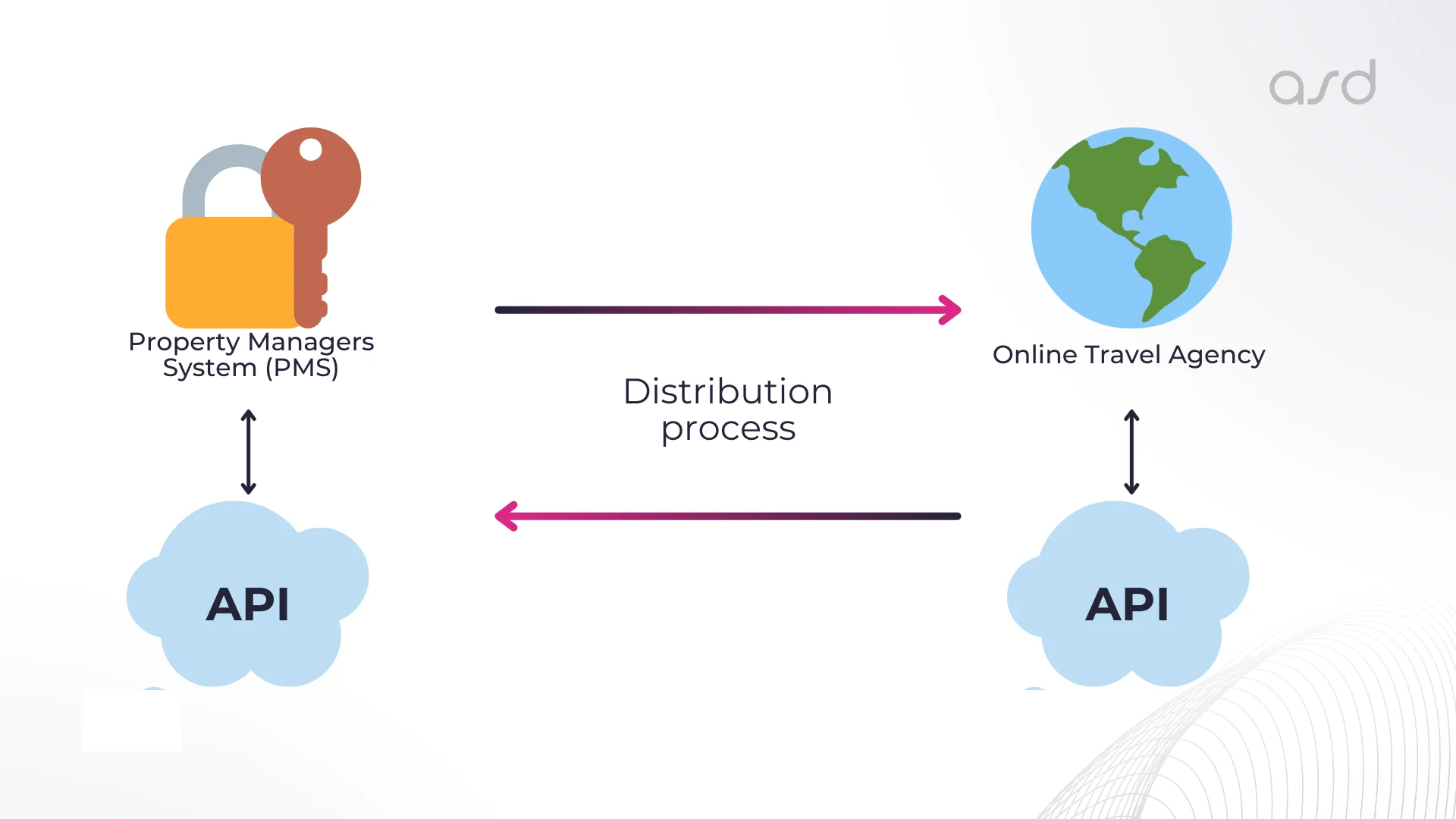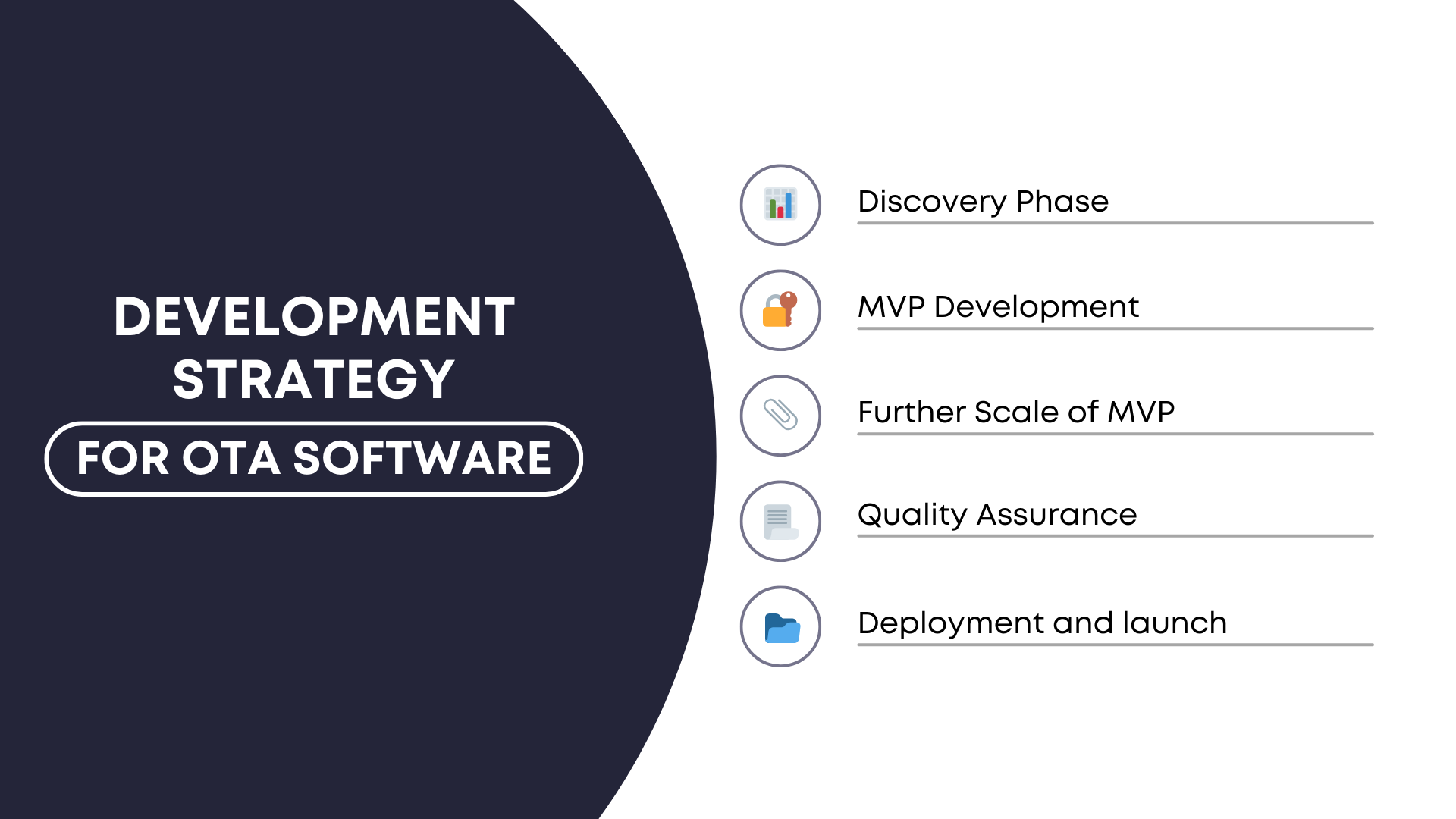Table of Content
- OTA software Grouping and Classification
- Key features of OTA software
- Booking engine – the core of OTA software
- Can OTA Marketplace Exist Without a Booking Engine
- Suppliers, Distribution and Online Travel Agency
- Development strategy for Online Travel Agency
- How ASD Team can help you with OTA website development
Build an OTA software for your Business
Book a callBuilding an OTA software or OTA booking engine may seem a concern for the upcoming players in the travel industry or for those who want to scale their travel business through travel website development. One of the main reasons for that is the solidly established names of such giants as Booking, Airbnb, Expedia, and Kayak. This leaves almost no place for OTA software development for both online travel agencies that want to have their own booking website, and for those who want to build their revenue stream around similar software types. Is it even possible to find a place in this competitive market? If the answer is “yes “, then how to do it, what features to include, and what steps should you follow to create a perfect travel niche product?
OTA software Grouping and Classification
Before going straight into the development and features, let’s first put your product in the right category. It’s a great practice to start here since it will help you define the group you want your OTA to belong to and emphasize the uniqueness of your future platform. As a rule, such products can be grouped either geographically or by the scope of services. Understanding your business processes can also help in defining the scope and services of your OTA in the travel industry.
Geographic classification
- Global (e.g. Airbnb, since it isn’t restricted by the choice of the destination). Put your company into this group if your travel agency offers tours that are not limited to one country (or if your marketplace with tours should cover worldwide destinations.
- Destination-specific (e.g. Vegas.com, since it offers trips to a single place and only). It is your category if you offer tours only in Greece as for example. As a rule, this category is more suitable for narrow-niche travel agencies.
Why it’s important? When you come to the development company with a basic understanding of the classification of the OTA products, you are therefore shortening the time for the Discovery Phase, where all the further planning of your product development happens and which covers all these questions regarding your business specifics.
Service-based classification
- All-in-one (e.g. Expedia, since it offers not only accommodations, hotel booking, cars, cruises, flights, car rentals, OTA booking engine and even more). If you don’t want to limit your business to only tours but also want to provide additional services to your website visitors, then select this group.
- Niche/service specific (seniorliving.com, since it serves the needs of a specific audience). You are focusing only on one specific type of service – tours (may they be only on jeeps or horses).
If you choose to be global and provide as many additional services as possible except for tours, the travel website development or a travel product would take longer and would cost a higher price than the product featuring only one service. Do not matter what category you choose, you already should have an answer to questions like how to choose a technology stack, and what will be my tech stack.
Key features of OTA software
Moving on to the next step – selecting the key features for your product. We can divide OTA software into
- the front-end side – a main platform, website or application, where travelers make their bookings;
- the back-end side which comprises the key pillar of OTA – the booking engine;
- the connectivity side that includes integrations with Global Distribution Systems (GDS), wholesalers, reservation systems, etc.
Based on this, we can outline the main users and capabilities each of them should be able to have:
Travelers/Customers
The end-users who visit the OTA platform to search for, book, and manage their travel arrangements. They should be able to:
- Browse and search for tours (and flights, hotels, car rentals, and other travel services, if you provide such.
- Compare options based on price, amenities, and reviews.
- Make bookings and payments, as well as direct bookings.
- Manage reservations.
- Provide reviews and feedback on their experiences.
Travel Agents
They use the platform to book travel on behalf of their clients. Their interactions should include:
- Access special rates and inventory not available to the general public
- Manage multiple client bookings.
- Handle payments and invoicing for clients.
Admin/OTA Operators
These are the internal staff members who manage and maintain the OTA platform. They:
- Manage user accounts, modify property and tours details.
- Monitor transactions and handle payment processing.
- Analyze data and generate reports.
All these roles and functions can be modified according to your specific requests. But to allow all the above-mentioned capabilities to be smoothly integrated and performed by the users, the travel website development should cover a multiple number of features:
Search and Filter
This point is as clear as it is since you want your users to be able to easily look and find the trip, property, or flight they are looking for. Having additional filters and providing opportunities for the users to refine their travel options based on price, location, etc will contribute to your business only in a good way.
Payments
It’s always nice to provide travelers with multiple options for payments, including credit/debit cards, PayPal, digital wallets, or bank transfers. Ensure a seamless experience for all types of users and don’t lose any client simply because you didn’t have the right payment option on your website.
Maps Integration
By linking the maps to your website, you provide another value for the users. They will be able to see the hotel’s location or accommodation on the same page they’re planning to book.
Property details page
The guest must make up their mind about booking a specific property. This page would allow the customers to see the photos, availability, booking rules, and more on a separate
Booking engine
Except for its main function – direct bookings on the website, a booking engine with advanced booking functionality can serve as a tool for verification of the availability, reservations, and payments, and even provide email confirmations. This is the key feature of your product and requires most of your attention during the development. Dive into our article and find out more about how to develop your online booking engine and what alternatives are there.
Beyond functionality, these features play a key role in user retention. If you’re looking to increase repeat bookings, take a look at how they influence your travel app retention rate.

If you have an OTA startup idea but need help finding developers, feel free to check our tips on hiring software developers for your startup. There you will find answers to the most popular questions like:
Booking engine – the core of OTA software
Understanding the OTA booking engine is crucial because it serves as the backbone of any online travel agency (OTA). Here’s why integrating a booking engine is essential:
- Centralized Booking Management and Automated Processing
The booking engine acts as the central hub, connecting with various suppliers (airlines, hotels, car rentals) to provide real-time availability and pricing. Due to this, customers get up-to-date information and can make instant bookings without manual intervention.
- Payment Integration
A booking engine integrates with payment gateways to process secure online payments, supporting various payment methods. This ensures smooth and secure transactions, providing a seamless payment experience for customers.
- Inventory Control
By connecting to property management systems (PMS) and other supplier systems, the booking engine manages inventory in real-time, preventing overbooking and ensuring accurate availability of information.
- Customization and Flexibility
Travel agents and administrators can use the booking engine to create custom travel packages, apply discounts, and manage special requests, catering to diverse customer needs.
- Data Collection and Analytics
The booking engine collects valuable data on customer bookings and interactions, offering insights through reporting and analytics. This helps optimize pricing strategies, marketing efforts, and service quality.
Let’s talk about your project? Feel free to ask any additional questions you might have. Our experts will be glad to assist you.

Can OTA Marketplace Exist Without a Booking Engine
While a travel website or marketplace can exist without a booking engine, it would rely heavily on manual processes or third-party integrations, which come with several limitations:
- Manual Processes: Without a booking engine, all bookings would need to be processed manually by travel agents. This is time-consuming, prone to errors, and inefficient.
- Limited Real-Time Updates: Without a direct connection to suppliers’ systems, providing real-time updates on availability and pricing would be challenging. This could lead to overbooking, misinformation, and poor customer experiences.
- Payment Handling: Managing payments securely and efficiently would be more complex without integrated payment gateways. Customers might face a fragmented payment experience, and the agency would have to handle financial transactions manually.
- Lack of Automation: Automation is key to scaling an online travel agency. Without it, handling large volumes of bookings, changes, and cancellations becomes cumbersome and less responsive to customer needs.
OTA booking engine is not an absolute necessity for a travel website marketplace to exist, but it is essential for providing a seamless and efficient service and experience for the travelers. It automates and centralizes critical functions, ensuring the marketplace can offer real-time information, secure payments, and personalized services to its customers. Therefore, most modern OTAs software incorporate a booking engine to enhance their operational capabilities and customer satisfaction.
Looking for a tech partner to develop an OTA software?
Suppliers, Distribution and Online Travel Agency
Now, let’s explore how travel products, such as hotels and airline tickets, reach the online travel agency. So, how does information get from the provider to the traveler? Some companies offer white label solutions to help smaller agencies compete by providing customizable platforms that enhance their offerings without the need for extensive resources.

- Global Distribution Systems (GDS):
GDS platforms serve as a large network that connects travel agents (TAs and OTAs) to a vast inventory of hotels, flights, and car rentals. Major GDS providers include Amadeus, Sabre, and Travelport. Travel agencies access GDS data through specialized software or APIs, enabling them to search, compare, and book travel products from multiple suppliers seamlessly.
- Supplier Websites and Extranets:
Many airlines, hotels, and tour operators provide dedicated portals or extranet platforms for travel agencies to access their inventory directly. These platforms allow agencies to view real-time availability, pricing, and special offers, and make bookings without intermediaries. Accessing supplier websites and extranets often requires authentication and may involve integration with the agency’s booking system.
- Wholesalers and BedBanks:
Wholesalers, or bedbanks, buy rooms in bulk at discounted rates and resell them to travel agents and OTAs. These wholesalers typically offer APIs or XML feeds that allow agencies to access their inventory and make bookings.
- Content Management Systems (CMS):
For niche or specialized tours and activities, travel agencies may rely on content management systems (CMS) to curate and manage their inventory. CMS platforms enable agencies to create custom tour packages, upload content, set pricing, and manage bookings. While not as comprehensive as GDS or supplier platforms, CMS solutions offer flexibility and customization for specific travel niches.

- Direct Connections and New Distribution Capabilities (NDC):
NDC allows airlines to connect directly with OTAs and other providers using a standardized XML format, bypassing the GDS. The adoption of NDC is growing, offering more direct connections with specific airlines.
If you are looking to develop your own OTA booking software, these solutions can provide significant benefits in today’s competitive market. You can increase travel options, ensure a smooth booking experience for your customers, and achieve long-term success.
Development strategy for Online Travel Agency
Building a platform that successfully connects travelers with tours, hotels, transportation, and unique travel services requires a series of steps in developing a travel website and an online travel group. This is our detailed plan for growing your own OTA:
- Discovery Phase:
Begin with a comprehensive discovery phase to define specific requirements, your preferences, and industry trends.
Develop an MVP that includes essential features for launching your OTA platform. Focus on core functionalities: search and booking capabilities, user registration, and payment processing.
- Further Scale of MVP:
After launching your MVP, identify areas for improvement and prioritize additional features. Continuously iterate and enhance your platform and scale your MVP gradually by adding new features, expanding your travel inventory, and improving user experiences.
- Quality Assurance (QA):
Conduct thorough QA testing throughout the development process to ensure the reliability, security, and performance of your OTA platform. Test functionality, usability, etc. to identify and address any issues before launch.
- Deployment and launch:
Post-launch, provide ongoing maintenance to ensure the smooth operation of your OTA platform. Resolve any technical issues promptly, and provide timely customer support to address user inquiries and concerns.

How ASD Team can help you with OTA website development
As we can see, OTA software development presents some challenging conditions and opportunities in a dynamic and evolving travel agency world. At ASD Team, we specialize in providing expert custom software development outsourcing services tailored to the specific needs and requirements of travel and hospitality companies. We can offer two flexible approaches to ensure your OTA project aligns with your vision:
- From Scratch OTA Development:
Even if you don’t have an existing OTA platform and are starting from scratch, we can build a fully customized OTA solution from scratch. Our professional team will work carefully with you to understand your unique requirements, create a user-friendly interface, and implement all the features you need to build an effective and scalable OTA platform.
- Existing OTA Upgrade:
If you already have an OTA platform, we can improve performance by adding new features, integrating with the third-party offering, and optimizing overall performance. We can also provide ongoing protection and support to ensure your OTA is up-to-date and robust.
Through our extensive experience and in-depth knowledge of the complexities of OTA software development and improvement, we foster quality and end-results meeting your initial expectations. Our team of skilled professionals works closely with clients to design, leverage, and implement customized OTA structures that deliver exceptional pricing and overall performance. Feel free to contact us!
OTA software, also known as Online Travel Agency Software, is a platform that allows you to manage and sell tour products along with hotels, flights, automobile rentals, and activities through a patron-pleasant online interface. It acts as the spine of your online adventure commercial organization connecting you with suppliers, streamlining the reserving gadget, and imparting an unbroken experience to your customers.
There are some basic features of OTA Software we were talking about:
- Search and Filter
- Maps Integration
- Payments
- Property details page
- Booking Engine
1. Define your aims
Consider your target audience, the products you have to offer, and the features that may be most important for your business.
2. Choose your methodology:
- Start from scratch: If you don’t have an existing platform, consider partnering with a software development company like ours to create a custom OTA solution to suit your needs.
- Improve your existing OTA: If you already have a platform, don’t forget to find improvements and integrate new features and functionality through development services.
3. Partner with an expert
Choose a reputable software development organization with experience in building OTA projects. We, as a development company, can guide you through the entire technology, from needs analysis and design to development, implementation, and training.
OTA software, also known as Online Travel Agency Software, is a platform that allows you to manage and sell tour products along with hotels, flights, automobile rentals, and activities through a patron-pleasant online interface. It acts as the spine of your online adventure commercial organization connecting you with suppliers, streamlining the reserving gadget, and imparting an unbroken experience to your customers. There are some basic features of OTA Software we were talking about: 1. Define your aims Consider your target audience, the products you have to offer, and the features that may be most important for your business. 2. Choose your methodology: 3. Partner with an expert Choose a reputable software development organization with experience in building OTA projects. We, as a development company, can guide you through the entire technology, from needs analysis and design to development, implementation, and training.Questions? Answers!
What is OTA Software?
What are the key features of OTA Software?
Where do I start with the OTA development?
